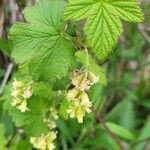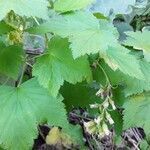Shrubs 1-2 m tall. Branchlets slender, pubescent, yellow glandular, unarmed. Buds brown, ovoid, 2.5-5 mm, pubescent and glandular, apex obtuse. Petiole 2-5 cm, pubescent and sparsely yellow glandular, sometimes plumose hairy near base; leaf blade broadly ovate to suborbicular, 2.5-6 × 3-7(-8) cm, abaxially pubescent along veins, adaxially glabrous, yellow glandular on both surfaces, base cordate or subtruncate; lobes 3-5, ovate to triangular-ovate, margin deeply serrate or doubly serrate, apex acute; terminal lobe slightly longer than lateral ones. Racemes pendulous, (4-)5-8 cm, 8-20-flowered or more; rachis and pedicels pubescent; bracts lanceolate to linear, 6-10 mm, pubescent, rarely sparsely glandular. Flowers bisexual; pedicel 2-4 mm. Calyx yellowish white, pubescent; tube campanulate to shortly cylindric, 3-5 mm; lobes spreading then reflexed, oblong to ligulate, 3.5-6 mm. Petals yellowish white, ligulate, 2.5-4.5 mm. Stamens subequaling petals; anthers oblong, apex with nectary. Ovary glabrous. Style equaling or slightly longer than stamens, entire or stigma 2-lobed. Fruit black, subglobose, 0.8-1 cm, glabrous. Fl. May, fr. Jun-Jul.
Stems erect, unarmed; lvs broadly truncate to shallowly cordate at base, 3–5-lobed, gland-dotted and sparsely villosulous beneath; racemes drooping, many fld; pedicels 0–2 mm, much exceeded by the conspicuous lanceolate bracts; hypanthium above the ovary narrowly campanulate, 3.5–4.5 mm; sep greenish-white or yellowish, oblong-ovate, 4.5–5 mm, glabrous or very sparsely villosulous; pet oblong, very blunt, 2.5–3 mm; fr black, glabrous; 2n=16. Moist woods; N.S. to Man. and Alta., s. to Del., W.Va., Ind., Io., Nebr., and Colo. Apr., May. (R. floridanum)
A small shrub. It does not have prickles. It grows about 1 m high. The leaves are simple and alternate. They are rounded with 3-5 pointed lobes. The leaves are 10 cm wide. There are double teeth along the edge. The flowers are creamy white. They are bell shaped and hang in clusters in the axils of the leaves. The fruit are smooth round black berries.






